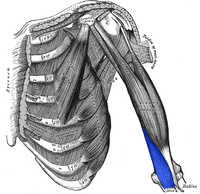Brachialis muscle
| Brachialis muscle |
|---|

|
| origin |
| Anterior surface of the humeral shaft |
| approach |
| Anterior surface of ulna ( ulnar tuberosity ) |
| function |
| Flexing elbows |
| Innervation |
| Musculocutaneous nerve and parts of the radial nerve , both from the brachial plexus |
| Spinal segments |
| C5, C6 |
The brachialis muscle ( Latin for "upper arm muscle ") is a skeletal muscle and lies behind the biceps brachii muscle on the outside of the upper arm . Its upper third is covered by the deltoid muscle .
function
The muscle brachial draws as the biceps, the forearm upward bends ( flexes ) so the arm in the elbow , especially in pronated forearm (palm down). In contrast to the biceps, the brachialis muscle flexes the forearm in both the pronation and supination position , since it attaches to the ulna. It is even stronger than the biceps brachii muscle, which is not only due to the mass and the larger physiological cross-section of this muscle, but also to the fact that it only extends over one joint (monoarticular), the elbow joint , and not like the M. biceps brachii also over the shoulder joint (biarticular). This enables him to transfer his power better. When a heavy load is to be lifted, the brachialis muscle does most of the work and initiates flexion when the arm is still fully extended.
The antagonist is the triceps brachii muscle of the same arm.
Varieties
Usually the brachialis muscle attaches to the outer, weaker forearm bone, the ulna . Occasionally, however, it has grown on the spoke . However, this variety does not lead to any difference in the load capacity, because the ulna and radius are connected by solid fibers ( membrana interossea antebrachii ) and hold all loads together.